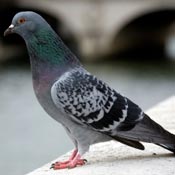Birds and Bird management
Excessive numbers of birds in an urban setting can cause the following:
- Disease transmission
- Nests causing secondary pest infestations (ie mites, beetles, moths, mites)
- Structural damage (by ammonia present in bird droppings)
- visual degradation
- Health & safety: slipping on guano. Corrosive dust accumulation in attics.
In addition crops can be damaged by certain bird species associated with rural areas. For example, these include wood pigeons, corvids and canada geese.

Feral Town Pigeon
Birds and their droppings can spread a large number of pathogens. They include Campylobacter sp & Salmonellosis (food poisoning), Ornithosis, Histoplasmosis, Listerosis (meningitis, septicaemia) etc.
Protection of brids
The Wildlife and Countryside act 1981 protects all birds, their nests and eggs. To prevent damage, however, designated pest species are exempt from this. The following bird species can be killed or prevented from nesting by DEFRA’s general licence as a last resort option for control. Nevertheless, the use proofing methods such as spiking, scaring or netting should be a priority.
- feral pigeon
- wood pigeon
- lesser black-backed gull
- crow
- rook
- magpie
- jackdaw
- jay
- collared dove
- canada goose
- herring gull. Noteworthly, only destruction of nests and eggs are allowed.
